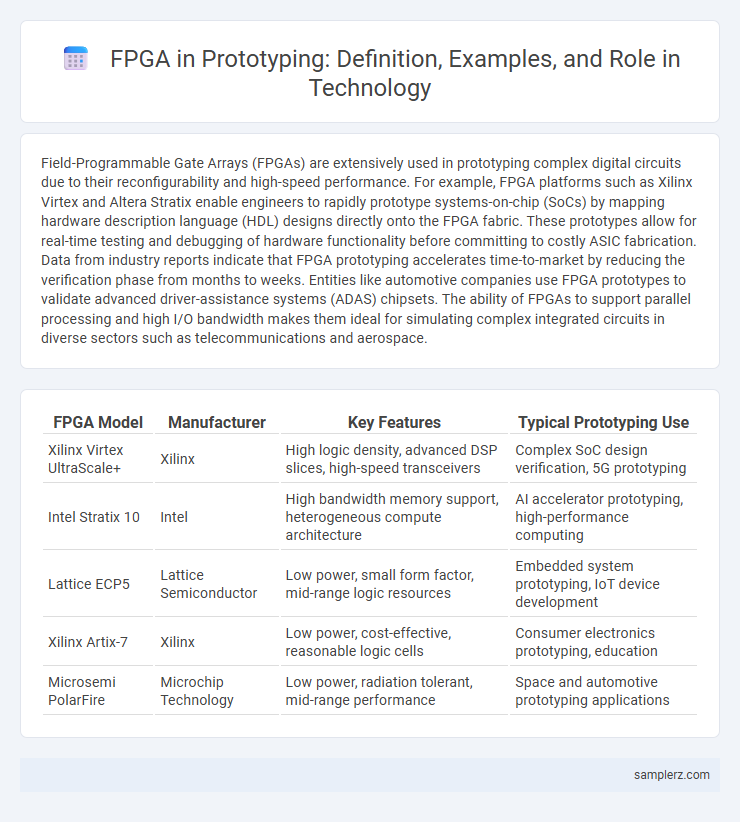Field-Programmable Gate Arrays (FPGAs) are extensively used in prototyping complex digital circuits due to their reconfigurability and high-speed performance. For example, FPGA platforms such as Xilinx Virtex and Altera Stratix enable engineers to rapidly prototype systems-on-chip (SoCs) by mapping hardware description language (HDL) designs directly onto the FPGA fabric. These prototypes allow for real-time testing and debugging of hardware functionality before committing to costly ASIC fabrication. Data from industry reports indicate that FPGA prototyping accelerates time-to-market by reducing the verification phase from months to weeks. Entities like automotive companies use FPGA prototypes to validate advanced driver-assistance systems (ADAS) chipsets. The ability of FPGAs to support parallel processing and high I/O bandwidth makes them ideal for simulating complex integrated circuits in diverse sectors such as telecommunications and aerospace.
Table of Comparison
| FPGA Model | Manufacturer | Key Features | Typical Prototyping Use |
|---|---|---|---|
| Xilinx Virtex UltraScale+ | Xilinx | High logic density, advanced DSP slices, high-speed transceivers | Complex SoC design verification, 5G prototyping |
| Intel Stratix 10 | Intel | High bandwidth memory support, heterogeneous compute architecture | AI accelerator prototyping, high-performance computing |
| Lattice ECP5 | Lattice Semiconductor | Low power, small form factor, mid-range logic resources | Embedded system prototyping, IoT device development |
| Xilinx Artix-7 | Xilinx | Low power, cost-effective, reasonable logic cells | Consumer electronics prototyping, education |
| Microsemi PolarFire | Microchip Technology | Low power, radiation tolerant, mid-range performance | Space and automotive prototyping applications |
Introduction to FPGA in Prototyping
Field-Programmable Gate Arrays (FPGAs) serve as versatile hardware platforms in prototyping complex digital circuits, offering reconfigurability that accelerates design validation and testing. Their ability to emulate integrated circuits enables engineers to identify design flaws and optimize performance before ASIC fabrication, significantly reducing development costs and time-to-market. Leading industries leverage FPGAs for real-time prototyping of processors, communication systems, and machine learning accelerators, highlighting their critical role in modern technology development.
Advantages of Using FPGA for Prototyping
FPGAs offer significant advantages for prototyping, including rapid design iteration and real-time testing that allow engineers to validate and refine complex digital circuits efficiently. Their reconfigurability enables multiple design modifications without the need for physical hardware changes, reducing both cost and development time. High-speed parallel processing capabilities in FPGAs facilitate accurate simulation of final ASIC behavior, improving design reliability before mass production.
Typical Applications of FPGA Prototyping
FPGA prototyping is extensively used in the development of complex SoCs, enabling hardware verification and performance validation before final silicon fabrication. Typical applications include automotive advanced driver-assistance systems (ADAS), high-speed networking devices, and consumer electronics such as smartphones and wearable technology. This approach significantly reduces time-to-market and design risks by allowing real-time testing and iterative design refinement.
Case Study: FPGA-Based Embedded System Prototype
The FPGA-based embedded system prototype demonstrated significant flexibility and rapid iteration in the development of a custom IoT device, enabling real-time hardware reconfiguration without extensive redesign. By leveraging the FPGA's parallel processing capabilities, the prototype achieved efficient signal processing and low-latency communication essential for smart sensor applications. This case study highlights FPGA's critical role in accelerating product development cycles and validating complex embedded designs before final ASIC fabrication.
FPGA vs ASIC in Rapid Prototyping
FPGA (Field-Programmable Gate Array) devices excel in rapid prototyping due to their reconfigurability, allowing designers to quickly test and iterate hardware designs without the long manufacturing cycles associated with ASICs (Application-Specific Integrated Circuits). Unlike ASICs, which require fixed, costly fabrication processes, FPGAs offer immediate deployment and hardware-level debugging, significantly accelerating development timelines. This flexibility makes FPGAs ideal for validating complex digital circuits and system functions before committing to ASIC production.
FPGA Prototyping for IoT Devices
FPGA prototyping plays a critical role in the development of IoT devices by enabling rapid hardware validation and functional testing before mass production. Its reconfigurable architecture allows designers to simulate complex IoT sensor networks and communication protocols, such as Zigbee and LoRaWAN, ensuring interoperability and performance optimization. This approach reduces time-to-market and enhances the reliability of embedded systems used in smart home automation, industrial monitoring, and wearable technology applications.
Real-World Example: Automotive FPGA Prototypes
In automotive development, FPGA prototypes enable rapid testing of advanced driver-assistance systems (ADAS) by providing configurable hardware platforms that simulate real-time sensor processing. Companies like Tesla and Bosch utilize FPGA-based prototyping to validate complex algorithms for collision avoidance and autonomous driving before committing to ASIC production. This approach accelerates design cycles and enhances system reliability in safety-critical automotive applications.
FPGA in Wireless Communication Prototyping
FPGAs play a crucial role in wireless communication prototyping by enabling rapid development and testing of custom signal processing algorithms. Their reconfigurable architecture allows engineers to simulate and optimize complex communication protocols such as 5G and Wi-Fi 6 in real-time hardware. This flexibility significantly reduces time-to-market and enhances the accuracy of wireless system designs.
FPGA Prototyping Workflow and Design Tools
FPGA prototyping streamlines hardware design verification by enabling rapid iteration and real-time testing of complex systems before ASIC fabrication. Key design tools such as Vivado Design Suite and Quartus Prime facilitate RTL synthesis, simulation, and debugging, accelerating the prototyping workflow. Integrating IP cores and leveraging high-level synthesis further optimize development cycles, reducing time-to-market for innovative semiconductor products.
Future Trends in FPGA Prototyping Technology
Future trends in FPGA prototyping technology emphasize increased integration of AI-driven design tools that accelerate development cycles and enhance accuracy in hardware emulation. Advancements in heterogeneous FPGA architectures incorporate specialized processing units optimized for machine learning and 5G applications, enabling higher performance and power efficiency. Cloud-based FPGA prototyping platforms offer scalable resources and remote collaboration capabilities, transforming how engineering teams approach hardware verification and system validation.

example of FPGA in prototyping Infographic
 samplerz.com
samplerz.com